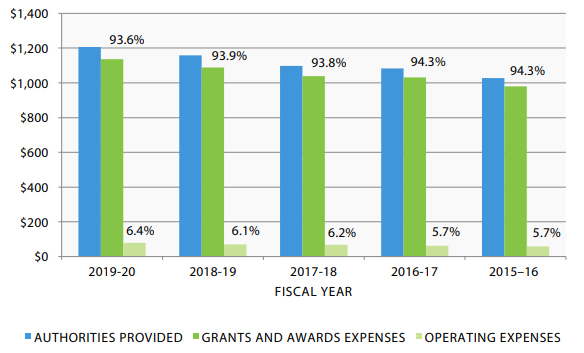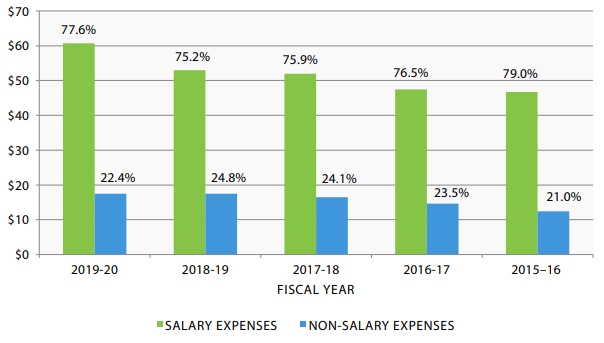Canadian Institutes of Health Research Annual Report 2019–20
Contents
- Chair’s Message
- Providing Stewardship and Accountability
- Financial Statement Discussion and Analysis
- Financial Statements
Chair’s Message

Chair of the Governing Council
On behalf of the Governing Council, I am pleased to present the 2019‑20 Annual Report of the Canadian Institutes of Health Research (CIHR), the Government of Canada’s health research funding agency.
It has been a remarkable year. In the period prior to COVID‑19’s extraordinary impact, CIHR had engaged extensively with the health research community as well as our federal, provincial and territorial partners to gather insights into the development of a new Strategic Plan. As we continue to look to the future, setting a course for CIHR also will be shaped by the waves of change stemming from COVID‑19 and the growing recognition of equity, diversity and inclusion as fundamental influences on our health and health system. With the benefit of a stable executive leadership team and a complete membership on its Governing Council, CIHR is prepared to launch a new vision, even as we celebrate the 20th anniversary of the establishment of the agency. Over the course of the next few months, CIHR will examine how the Strategic Plan can be informed by the pandemic context, with the intention of launching in early 2021. As a vision to guide CIHR’s operations and investments for the next decade, the plan will inspire new opportunities for health research to transform our health and our health system for the benefit of all.
Canada’s Health Research Response to COVID‑19
Under the challenging conditions imposed by the pandemic, researchers across the country quickly focused on new research to inform the development and implementation of medical and social counter measures, including those required to rapidly detect, manage, and reduce the transmission of COVID‑19. Canadian health researchers from a wide range of disciplines were ready to generate much-needed evidence to develop health policies as well as to improve testing, therapeutics, and vaccines. The COVID‑19 pandemic has demonstrated the critical roles that CIHR and health research fulfill in the effort to ensure that evidence-informed responses are available at home and around the globe. From the outset of the pandemic, CIHR has been a key partner in the federal response to COVID‑19 – in collaboration with the Natural Sciences and Engineering Research Council of Canada, the Social Sciences and Humanities Research Council, Genome Canada and the International Development Research Centre. CIHR also fulfills a leadership role at the Global Research Collaboration for Infectious Disease Preparedness (Glo‑PID‑R) – a unique international network of research funding organizations – in establishing a global research blueprint.
On March 6, 2020, the Minister of Health and other leaders announced the investment of nearly $27 M to support research teams in a rapid research response to address the pressing need for new scientific evidence required to shape COVID‑19 responses. Through the Canadian 2019 Novel Coronavirus (COVID‑19) Rapid Research competition, CIHR worked with many partners to award funding to 99 research teams – bolstering Canadian researchers’ contributions to the global efforts to quickly and effectively develop and apply new knowledge in order to contain COVID‑19.Remarkably, this competition was launched and brought to fruition in less than one month, thanks to an incredible response from the research community – demonstrating the importance of accelerated support for science during times of crisis. Results of these important studies are to be shared rapidly and widely – including with the Public Health Agency of Canada, the World Health Organization, and many other public health and research bodies.
Delivering the funding where it is most needed requires strong systems, infrastructure and the dedication of CIHR staff. With this in mind, the Government of Canada officially recognized CIHR as providing a critical service during this pandemic. CIHR also recognized the importance of enabling Canadian health researchers who rely on CIHR funding to retain capacity (e.g., highly qualified personnel; laboratory materials), helping them to continue their important work on many other pressing health needs, including research focused on population health inequities, novel cancer therapies, mental health, and many other health and health systems issues.
Supporting Government of Canada Initiatives
In 2019‑20, CIHR continued to make significant progress towards the Action Plan: Building a Healthier Future for First Nations, Inuit, and Métis Peoples, which commits CIHR to further strengthen Indigenous health research in Canada. Informed by community engagement, CIHR’s Institute of Indigenous Peoples’ Health developed a strategic plan that will contribute to improving Indigenous health outcomes, and aligns with the United Nations Declaration on the Rights of Indigenous Peoples as well as the Truth and Reconciliation Commission of Canada Calls to Action.
In its continued commitment to enable support for research, CIHR collaborated with federal colleagues to advance the evidence-based policy agenda of the Government of Canada. CIHR provided evidence to support the Government of Canada’s responses to the ongoing opioid crisis as well as the legalization of cannabis. In January 2020, CIHR and the CIHR Institutes of Cancer Research (ICR); Circulatory and Respiratory Health (ICRH); Human Development, Child and Youth Health (IHDCYH); and Neurosciences, Mental Health, and Addiction (INMHA), in partnership with the Canadian Cancer Society, launched the Health Effects of Vaping Catalyst Grant funding opportunity to support research to address urgent knowledge gaps related to the health effects of vaping in youth and adults. CIHR also supported the development and launch of key initiatives, including the Federal Framework on Posttraumatic Stress Disorder and A Dementia Strategy for Canada. CIHR continues to participate in the implementation of the Pan-Canadian Antimicrobial Resistance Action Plan.
CIHR also played a leadership role in the development of the Canada Research Coordinating Committee’s (CRCC) strategic plan to guide the building of new models to support the future of Indigenous research and training. In addition, CIHR committed over $100 million to support Indigenous community-based health research anchored in the priorities and values of Indigenous Peoples, through the Network Environments for Indigenous Health Research program.
CIHR continues to work closely with other federal granting agencies to deliver on the shared commitment to a broad range of initiatives, including:
- The release of the Tri-Agency Statement on Equity, Diversity and Inclusion (EDI) to capture the agencies’ overarching commitments to equitable and inclusive access to research support and participation in the research system.
- The Dimensions pilot project – to publicly recognize post-secondary institutions that identify and address systemic barriers experienced by members of underrepresented or disadvantaged groups – and, ultimately, to develop action plans to generate positive change in systems, practices and culture.
- The ratification of the San Francisco Declaration on Research Assessment (DORA), a global initiative to support the development and promotion of best practice in assessment of scholarly research, reaffirming the shared commitment to excellence in research evaluation and the importance of knowledge translation.
Recognizing the importance of investing in young Canadians, the Federal Budget 2019 proposed investments to expand paid parental leave to students receiving federal grants or scholarships. In addition, support was identified for 500 additional master’s awards and 167 additional three-year doctoral awards annually through the Canada Graduate Scholarships program. Furthermore, through the New Frontiers in Research Fund (NFRF), a total of investment of $38M supported 157 early career researchers. These investments will help support the next generation of researchers and further improve equity and inclusion in the research community, bringing new ideas and perspectives into focus as Canadian health researchers tackle some of the worlds’ greatest challenges.
With respect to international collaborations, through the CRCC, CIHR contributed to the development of a framework for international cooperation and engagement that positions Canada as an influential partner in global research and innovation, and guides interagency collaboration on international research initiatives. Furthermore, the launch of the 2020 Horizon Global Platform also has opened new funding opportunities for Canadian researchers who are partners on successful projects funded through eligible calls under Horizon 2020, and the 2020 Transformation Competition to support large-scale, Canadian-led interdisciplinary research projects that address a major challenge with the potential to realize significant and lasting change.
Looking to the Future
A healthier future will require much of CIHR as well as Canada’s health research community. With the oversight of CIHR’s Governing Council, and under the direction of CIHR’s President, CIHR will continue to be at the forefront in supporting the best science required to create a healthier future for generations to come. CIHR also will continue to work to address systematic racism and other systemic biases that hold back the health and social progress that science has the power to inform. As we go forward together, let us continue to listen with humility and support actions to promote and protect equity, diversity and inclusion. In the year to come, our strategic outlook will be informed by a “new normal” and further strengthened by the continued engagement of communities and partners.
It is clear that our health and health system needs to be powered by outstanding research – and, CIHR will continue to deliver on research excellence and knowledge translation. I invite you to read the financial details of this report to learn more about the investment that enables CIHR, as the Government of Canada’s health research funding agency, to support new scientific knowledge and enable its translation into improved health and a strengthened Canadian health care system.
Sincerely,
Dr. Jeannie Shoveller
Chair, Governing Council
Providing Stewardship and Accountability
CIHR Governing Council
CIHR reports to Parliament through the Minister of Health. Its Governing Council comprises a group of up to 18 distinguished Canadians who together provide oversight and strategic direction for the organization and evaluate its overall performance.

Jeannie Shoveller
Chair
Vice President
Research & Innovation, IWK Health Centre
Professor
Community Health & Epidemiology, Dalhousie University

Debbie Fischer
Executive-in-Residence
Rotman School of Management
Executive Associate, KPMG

Louise Lemieux-Charles
Professor Emeritus
Institute of Health Policy, Management and Evaluation
Dalla Lana School of Public Health
University of Toronto

Alice B. Aiken
Vice-Chair
Vice President (Research & Innovation)
Dalhousie University

Dominic Giroux
President and CEO
Health Sciences North and the Health Sciences North Research Institute

Stephen Lucas
(Ex-officio, non-voting member)
Deputy Minister
Health Canada

Paul Allison
Faculty of Dentistry
McGill University

Diane Gosselin
President and Chief Executive Officer
CQDM

Amélie Quesnel-Vallée
Professor
Departments of Sociology & Epidemiology
McGill University

Brenda Andrews
Charles H. Best Chair of Medical Research
University Professor and Director
Donnelly Centre for Cellular and Biomolecular Research

Nada Jabado
Senior Scientist
RI‑MUHC Glen site Child Health and Human Development Program

Michael Salter
Chief of Research and
Senior Scientist
Neurosciences and Mental Health
The Hospital for Sick Children

Mark S. Dockstator
Former President
First Nations University of Canada

Brianne Kent
Research Fellow
Brigham and Women’s Hospital and Harvard Medical School

Michael Strong
(Ex-officio, non-voting member)
President, CIHR

Don Ferguson
Former Deputy Minister of Health for New Brunswick

Josette-Renée Landry
Founder and CEO
Streamline Genomics

Marcello Tonelli
Senior Associate Dean (Health Research), Cumming School of Medicine
Associate Vice President
(Health Research), University of Calgary
Financial Statement Discussion and Analysis
Introduction
The following Financial Statement Discussion and Analysis (FSD&A) should be read in conjunction with the Canadian Institutes of Health Research (CIHR) financial statements and accompanying notes for the year ended March 31, 2020.
The responsibility for the integrity and objectivity of the FSD&A rests with the management of CIHR. The purpose of the FSD&A is to highlight information and provide explanations to enhance the user’s understanding of CIHR’s financial position and results of operations, while demonstrating CIHR’s accountability for its resources. Additional information on CIHR’s performance is available in the CIHR Departmental Results Report, and information on its plans and priorities is available in the CIHR Department Plan.
Overview
The Canadian Institutes of Health Research was established in June 2000 under the Canadian Institutes of Health Research Act. It is listed in Schedule II to the Financial Administration Act as a departmental corporation. CIHR’s objective is to excel, according to international standards of scientific excellence, in the creation of new knowledge, and its translation into improved health, more effective health services and products, and a strengthened Canadian health care system.
CIHR’s budget is allocated through authorities approved by Parliament. CIHR has separate voted authorities for operating expenses and for grants/awards. Authorities provided to CIHR by Parliament do not parallel financial reporting according to Canadian public sector accounting standards, since authorities are primarily based on cash accounting principles. Consequently, items recognized in the Statement of Financial Position, the Statement of Operations and Departmental Net Financial Position, the Statement of Change in Departmental Net Debt, and the Statement of Cash Flows are not necessarily the same as those provided through authorities from Parliament. Note 3 of the Financial Statements provides users with a reconciliation between the two bases of reporting.
Highlights
CIHR’s financial results in 2019‑20 are consistent with those of the preceding fiscal year, taking into account increases in parliamentary authorities available.
1.Statement of Financial Position
| As at March 31 | 2020 | 2019 | % change |
|---|---|---|---|
| Total liabilities | $13.9 | $13.4 | 3.7 % |
| Total financial and non-financial assets | $18.3 | $19.0 | (3.7)% |
The slight increase in total liabilities of $0.5 million is primarily due to an increase in the employee vacation accrual ($1.0 million) as a result of increased salary rates and additional days leave granted in compensation for the Phoenix pay system, as well as small increases in accounts payable and accrued liabilities ($0.5 million) which mainly relates to payables due to other government departments. These increases were offset by a decrease in deferred revenue ($1.0 million) caused by both fewer donations received in the year and an increased use of prior year donations towards CIHR’s contributions to health research.
The balance in total financial and non-financial assets decreased by $0.7 million over the prior year. The decrease is primarily attributed to a decrease ($1.9 million) in the net book value of tangible capital assets as a result of increased amortization and fewer acquisitions than in previous years. There was also a decrease in the due from the consolidated revenue fund of $0.6 million. These decreases were offset by a $1.8 million increase in accounts receivable, largely driven by a significant increase in amounts owing from other government departments.
2. Statement of Operations and Departmental Net Financial Position
| For the year ended March 31 | 2020 | 2019 | % change |
|---|---|---|---|
| Total expenses | $1,214.8 | $1,159.4 | 4.8% |
| Net cost of operations before government funding and transfers | $1,208.2 | $1,155.2 | 4.6% |
The increase in both total expenses (4.8%) and in net cost of operations before government funding and transfers (4.6%) are mainly attributable to Parliamentary authorities provided to CIHR by the Government of Canada which increased by $46.7 million from the prior fiscal year, as well as increases in items impacting results but not authorities (such as amortization and services without charge).
3. Variance Analysis
3.1 Variances between current year actual results and budget
As noted, CIHR is funded by the Government of Canada through Parliamentary authorities. CIHR’s 2019‑20 year-end Parliamentary authorities of $1,205.7 million represent an increase of $46.7 million (or 4.0%) compared to CIHR’s year-end authorities in 2018‑19 ($1,159.0 million).
This increase is a key factor to note when comparing current year and prior year results for CIHR. Part of the increase relates to funding from Budgets 2018 and 2019 which were designed to increase annually over several years (up to five). The remaining increase is due to $27.1 million of additional Parliamentary authorities provided during the year via the Supplementary Estimates and other adjustments as follows:
| 2019‑20 Main Estimates (in millions of dollars) | $1,178.6 |
|---|---|
| Increased funding for Canada Excellence Research Chairs program | 3.8 |
| Increased funding for Canada Research Chairs program | 3.0 |
| Funding for research against cervical cancer in Canada | 2.0 |
| Net transfers from other government departments | 13.1 |
| Treasury Board Secretariat (TBS) salary reimbursements | 3.8 |
| 2018‑19 Operating budget carry-forward | 1.4 |
| Total increase in Parliamentary authorities | 27.1 |
| 2019‑20 Year-end Parliamentary authorities | $1,205.7 |
3.2 Variances between current year actual results and prior year actual results
| For the year ended March 31 | 2020 | 2019 | % change |
|---|---|---|---|
| Grants and awards | $1,136.5 | $1,088.9 | 4.4% |
| Operating expenses | $78.3 | $70.5 | 11.1% |
Grants and awards expenses increased by 4.4% (or $47.6 million) in 2019‑20 due to increased Parliamentary authorities provided to CIHR for grants (as outlined in section 3.1). Total operating expenses also increased by 11.1% ($7.8 million) over the previous year. This increase was mainly due to a 14.5% ($7.7 million) increase in salaries and employee benefits resulting from economic increases approved retroactively to 2018‑19 at a rate higher than anticipated, increased vacation liability discussed in section 1, as well as an increase of 29 FTEs compared to 2018‑19. The remaining categories increased or decreased marginally, resulting in a net $0.1 million increase. For example, amortization increased by $0.5 million as a result of assets under construction capitalized at the end of the previous year, while furniture, equipment and software decreased by $0.4 million as a result of one-time expenditures incurred in 2018‑19 such as a bulk purchase of software licenses and new audio-visual equipment for boardrooms.
4. Trend Analysis
4.1. Grants and Awards Expenses
(in millions of dollars)

Grants and Awards Expenses – Long Description
| 2019–20 | 2018–19 | 2017–18 | 2016–17 | 2015–16 | |
|---|---|---|---|---|---|
| Authorities provided | $1,205.7 | $1,158.9 | $1,098.4 | $1,083.2 | $1,028.3 |
| Grants and awards expenses | $1,136.5 | $1,088.9 | $1,038.8 | $1,031.1 | $980.6 |
| Operating expenses | $78.3 | $70.5 | $68.5 | $62.1 | $59.1 |
| Percentage grants and awards | 93.6% | 93.9% | 93.8% | 94.3% | 94.3% |
| Percentage operating expenses | 6.4% | 6.1% | 6.2% | 5.7% | 5.7% |
- The proportion of grants and awards expenses in relation to changes in the Parliamentary authorities fluctuate minimally from year to year.
- In 2019‑20, grants and awards expenses made up 93.6% of total expenses, as compared to 93.9% in 2018‑19.
4.2. Operating Expenses
(in millions of dollars)

Operating Expenses – Long Description
| 2019–20 | 2018–19 | 2017–18 | 2016–17 | 2015–16 | |
|---|---|---|---|---|---|
| Salary expenses | $60.7 | $53.0 | $52.0 | $47.5 | $46.7 |
| Non-salary expenses | $17.5 | $17.5 | $16.5 | $14.6 | $12.4 |
| Total | $78.2 | $70.5 | $68.5 | $62.1 | $59.1 |
| Percentage salary expenses | 77.6% | 75.2% | 75.9% | 76.5% | 79.0% |
| Percentage non-salary expenses | 22.4% | 24.8% | 24.1% | 23.5% | 21.0% |
- The ratio of operating expenses to total expenses was 6.4% in 2019‑20, as compared to 6.1% in 2018‑19.
- Salary and employee benefit expenses increased by $7.7 million (or 14.5%) in 2019‑20, as discussed in 3.2.
- In 2019‑20, salaries and employee benefits made up 77.6% of total operating expenses, as compared to 75.2% in the prior year.
Financial Outlook – 2020-21
Budget 2018 provided historic levels of new funding to reinvigorate Canada's research system, including the single largest investment in fundamental science in Canadian history. It also committed to ensuring that Canada's next generation of researchers—including students, trainees and early-career researchers—is more diverse. This new funding stemming from Budget 2018 is scheduled to continue increasing annually until 2021-22.
To further improve equity, diversity and inclusion in the research system, Budget 2019 proposed to provide a total of $14.2 million over five years, starting in 2019–20, and $3.3 million per year ongoing, to CIHR to expand parental leave coverage from six months to 12 months for students and postdoctoral fellows who receive granting council funding. As these students focus fully on their research, they may not be participating in the traditional labour market. As there is no typical employer-employee relationship, student researchers are unable to take advantage of parental leave benefits offered under the Employment Insurance program.
Additionally, Budget 2019 proposed to increase its investment in graduate students by creating more master’s level and doctoral scholarship awards through the Canada Graduate Scholarship program run by the three granting councils (CIHR, the Natural Sciences and Engineering Research Council, and the Social Sciences and Humanities Research Council). As a result, CIHR was allocated $31.9 million over five years, starting in 2019‑20, and $7.4 million per year ongoing, to help more students access graduate studies.
As Canada’s health research granting agency, CIHR plays a critical role in the Government’s COVID‑19 response in 2020-21 and beyond. Major research investments have been made to advance the efforts to understand and treat COVID‑19, as well as maintain income support for trainees whose programs have been affected due to the closure of academic research labs. While the situation continues to evolve, CIHR anticipates receiving $240.7 million in funding for the COVID‑19 response as follows:
- $114.8 million to support medical research and vaccine development;
- $87.6 million to support research trainees whose work was disrupted;
- $25.8 million for emergency research and innovation response measures; and
- $12.5 million to mitigate health, social and economic risks.
Financial Statements
Canadian Institutes of Health Research
Statement of Management Responsibility Including Internal Control over Financial Reporting
Responsibility for the integrity and objectivity of the accompanying financial statements for the year ended March 31, 2020, and all information contained in these financial statements rests with the management of the Canadian Institutes of Health Research (CIHR). These financial statements have been prepared by management using the Government of Canada’s accounting policies, which are based on Canadian public sector accounting standards.
Management is responsible for the integrity and objectivity of the information in these financial statements. Some of the information in the financial statements is based on management's best estimates and judgment, and gives due consideration to materiality. To fulfill its accounting and reporting responsibilities, management maintains a set of accounts that provides a centralized record of CIHR’s financial transactions. Financial information submitted in the preparation of the Public Accounts of Canada, and included in CIHR’s Departmental Results Report, is consistent with these financial statements.
Management is also responsible for maintaining an effective system of internal control over financial reporting (ICFR) designed to provide reasonable assurance that financial information is reliable, that assets are safeguarded and that transactions are properly authorized and recorded in accordance with the Financial Administration Act and other applicable legislation, regulations, authorities and policies.
Management seeks to ensure the objectivity and integrity of data in its financial statements through careful selection, training and development of qualified staff; through organizational arrangements that provide appropriate divisions of responsibility; through communication programs aimed at ensuring that regulations, policies, standards and managerial authorities are understood throughout CIHR; and through conducting an annual risk-based assessment of the effectiveness of the system of ICFR.
The system of ICFR is designed to mitigate risks to a reasonable level based on an ongoing process to identify key risks, to assess effectiveness of associated key controls, and to make any necessary adjustments.
A risk-based assessment of the system of ICFR for the year ended March 31, 2020 was completed in accordance with the Treasury Board Policy on Financial Management and the results and action plans are summarized in the annexFootnote 1.
The effectiveness and adequacy of CIHR’s system of internal control is reviewed by the work of internal audit staff who conduct periodic audits of different areas of CIHR’s operations, and by CIHR’s Audit Committee, which oversees management’s responsibilities for maintaining adequate control systems and the quality of financial reporting, and which recommends the financial statements to the President of CIHR and its Governing Council.
The financial statements of CIHR have not been audited.
Approved by:
Michael J. Strong, MD, FRCPC, FAAN, FCAHS
President
Dalia Morcos Fraser, CPA, CMA
Chief Financial Officer
Ottawa, Canada
July 8, 2020
Canadian Institutes of Health Research
Statement of Financial Position (Unaudited)
As at March 31
(in thousands of dollars)
| 2020 | 2019 | |
|---|---|---|
| Liabilities | ||
| Accounts payable and accrued liabilities (note 4) | $7,356 | $6,911 |
| Vacation pay and compensatory leave | 4,010 | 3,015 |
| Deferred revenue (note 5) | 1,797 | 2,821 |
| Employee future benefits (note 6) | 720 | 687 |
| Total liabilities | 13,883 | 13,434 |
| Financial assets | ||
| Due from Consolidated Revenue Fund | 9,153 | 9,733 |
| Accounts receivable (note 7) | 3,559 | 1,745 |
| Total financial assets | 12,712 | 11,478 |
| Departmental net debt | 1,171 | 1,956 |
| Non-financial assets | ||
| Prepaid expenses | 382 | 333 |
| Tangible capital assets (note 8) | 5,254 | 7,157 |
| Total non-financial assets | 5,636 | 7,490 |
| Departmental net financial position | $4,465 | $5,534 |
|
Contractual obligations (note 9) The accompanying notes form an integral part of these financial statements. |
||
Approved by:
Michael J. Strong, MD, FRCPC, FAAN, FCAHS
President
Dalia Morcos Fraser, CPA, CMA
Chief Financial Officer
Ottawa, Canada
July 8, 2020
Canadian Institutes of Health Research
Statement of Operations and Departmental Net Financial Position (Unaudited)
For the year ended March 31
(in thousands of dollars)
| 2020 | 2020 | 2019 | |
|---|---|---|---|
| Planned Results (note 2) |
|||
| Expenses | |||
| Funding health research and training | $1,178,571 | $1,174,893 | $1,122,040 |
| Internal Services | 35,739 | 39,886 | 37,358 |
| Total expenses | 1,214,310 | 1,214,779 | 1,159,398 |
| Revenues | |||
| Funding health research and training | 7,422 | 6,542 | 4,238 |
| Total revenues | 7,422 | 6,542 | 4,238 |
| Net cost of operations before government funding and transfers | $1,206,888 | $1,208,237 | $1,155,160 |
| Government funding and transfers | |||
| Net cash provided by Government of Canada | $1,199,522 | $1,149,067 | |
| Change in Due from the Consolidated Revenue Fund | (580) | (1,191) | |
| Services provided without charge by other government departments (note 11) | 8,226 | 7,399 | |
| Net cost of operations after government funding and transfers | 1,069 | (115) | |
| Departmental net financial position – beginning of year | 5,534 | 5,419 | |
| Departmental net financial position – end of year | $4,465 | $5,534 | |
|
Segmented information (note 12) The accompanying notes form an integral part of these financial statements. |
|||
Canadian Institutes of Health Research
Statement of Change in Departmental Net Debt (Unaudited)
For the year ended March 31
(in thousands of dollars)
| 2020 | 2019 | |
|---|---|---|
| Net cost of operations after government funding and transfers | $1,069 | $(115) |
| Change due to tangible capital assets | ||
| Acquisition of tangible capital assets | 385 | 1,959 |
| Amortization of tangible capital assets | (2,288) | (1,801) |
| Loss on disposal of capital assets | - | (54) |
| Total change due to tangible capital assets | (1,903) | 104 |
| Change due to prepaid expenses | 49 | (222) |
| Net (decrease) in departmental net debt | (785) | (233) |
| Departmental net debt – beginning of year | 1,956 | 2,189 |
| Departmental net debt – end of year | $1,171 | $1,956 |
|
The accompanying notes form an integral part of these financial statements. |
||
Canadian Institutes of Health Research
Statement of Cash Flows (Unaudited)
For the Year ended March 31
(in thousands of dollars)
| 2020 | 2019 | |
|---|---|---|
| Operating activities | ||
| Net cost of operations before government funding and transfers | $1,208,237 | $1,155,160 |
| Non-cash items: | ||
| Amortization of tangible capital assets | (2,288) | (1,801) |
| Services provided without charge by other government departments (note 11) | (8,226) | (7,399) |
| (Loss) on disposal of tangible capital assets | - | (54) |
| Variations in Statement of Financial Position: | ||
| Increase in accounts receivable | 1,814 | 577 |
| Increase / (decrease) in prepaid expenses | 49 | (222) |
| (Increase) / decrease in accounts payable and accrued liabilities | (445) | 1,118 |
| (Increase) in vacation pay and compensatory leave | (995) | (402) |
| Decrease in deferred revenue | 1,024 | 78 |
| (Increase) / decrease in future employee benefits | (33) | 53 |
| Cash used in operating activities | 1,199,137 | 1,147,108 |
| Capital investing activities | ||
| Acquisitions of tangible capital assets | 385 | 1,959 |
| Cash used in capital investing activities | 385 | 1,959 |
| Net cash provided by Government of Canada | $1,199,522 | $1,149,067 |
|
The accompanying notes form an integral part of these financial statements. |
||
Canadian Institutes of Health Research
Notes to the Financial Statements (Unaudited)
As at March 31
(in thousands of dollars)
1. Authority and objectives
The Canadian Institutes of Health Research (CIHR) was established in June 2000 under the Canadian Institutes of Health Research Act, replacing the former Medical Research Council of Canada. It is listed in Schedule II to the Financial Administration Act as a departmental corporation.
CIHR’s objective is to excel, according to international standards of scientific excellence, in the creation of new knowledge, and its translation into improved health, more effective health services and products, and a strengthened Canadian health care system. CIHR’s strategic outcome is as follows: Canada is a world leader in the creation, dissemination and application of health research knowledge. The strategic outcome is achieved based on two programs. The first program is Investigator-Initiated Health Research, to develop and support a well-trained base of world-class health researchers and trainees conducting research across all aspects of health, including biomedical research, clinical research, research respecting health systems, health services, the health of populations, societal and cultural dimensions of health and environmental influences on health, and other research as required. The goal of the Investigator-Initiated Health Research program is to advance health knowledge and to apply this knowledge in order to improve health systems and/or health outcomes. The second program is Priority-Driven Health Research, which provides funding to researchers for emergent and targeted research that responds to the changing health needs and priorities of Canadians across all aspects of health, including biomedical research, clinical research, research respecting health systems, health services, the health of populations, societal and cultural dimensions of health and environmental influences on health, and other research as required. The goal of the Priority-Driven Health Research program is to advance health knowledge and its application, in specific areas of research identified by CIHR in consultation with other government departments, partners and stakeholders, in order to improve health systems and/or health outcomes in these priority areas.
CIHR is governed by a Governing Council of up to 18 members appointed by the Governor in Council. Sixteen members, including the Chair, are voting members, and 2 are non-voting, ex officio members: the Deputy Minister and the President of CIHR.The Governing Council sets overall strategic direction, goals and policies and oversees programming, resource allocation, ethics, budget, planning and accountability.
CIHR has thirteen institutes that focus on identifying the research needs and priorities for specific health areas, or for specific populations, then developing strategic initiatives to address those needs. Each institute is led by a Scientific Director who is guided by an Institute Advisory Board, which strives to include representation of the public, researcher communities, research funders, health professionals, health policy specialists and other users of research results.
CIHR’s grants, awards and operating expenditures are funded by budgetary authorities. Employee benefits are funded by statutory authorities.
2. Summary of significant accounting policies
These financial statements are prepared using CIHR’s accounting policies stated below, which are based on Canadian public sector accounting standards. The presentation and results using the stated accounting policies do not result in any significant differences from Canadian public sector accounting standards.
Significant accounting policies are as follows:
Parliamentary authorities
CIHR is financed by the Government of Canada through Parliamentary authorities. Financial reporting of authorities provided to CIHR do not parallel financial reporting according to generally accepted accounting principles since authorities are primarily based on cash flow requirements. Consequently, items recognized in the Statement of Operations and Departmental Net Financial Position and in the Statement of Financial Position are not necessarily the same as those provided through authorities from Parliament. Note 3 provides a reconciliation between the bases of reporting. The planned results amounts in the “Expenses” and “Revenues” sections of the Statement of Operations and Departmental Net Financial Position are the amounts reported in the Future-oriented Statement of Operations (unaudited) included in the 2019‑20 Departmental Plan. Planned results are not presented in the “Government funding and transfers” section of the Statement of Operations and Departmental Net Financial Position and in the Statement of Change in Departmental Net Debt because these amounts were not included in the 2019‑20 Departmental Plan.
Net cash provided by Government
CIHR operates within the Consolidated Revenue Fund (CRF), which is administered by the Receiver General for Canada. All cash received by CIHR is deposited to the CRF and all cash disbursements made by CIHR are paid from the CRF. The net cash provided by Government is the difference between all cash receipts and all cash disbursements, including transactions between departments of the Government.
Amounts due from the Consolidated Revenue Fund (CRF)
Amounts due from CRF are the result of timing differences at year-end between when a transaction affects authorities and when it is processed through the CRF. Amounts due from the CRF represent the net amount of cash that CIHR is entitled to draw from the CRF without further authorities to discharge its liabilities.
Revenues
Funds received from external parties for specified purposes are recorded upon receipt as deferred revenue. Revenues are then recognized in the period in which the related expenses are incurred.
Deferred revenue consists of amounts received in advance of the delivery of goods and rendering of services that will be recognized as revenue in a subsequent fiscal year as it is earned.
Other revenues are recognized in the period the event giving rise to the revenues occurred.
Refunds of previous years' expenses
These amounts include the return of grants and awards funds to CIHR in the current fiscal year for expenses incurred in previous fiscal years due to cancellations, refunds of previous years' expenses related to goods or services, and adjustments of previous years' accounts payable. These refunds and adjustments are recorded as revenue.
Expenses
Grants and awards (transfer payments) are recorded as an expense in the year the transfer is authorized and all eligibility criteria have been met by the recipient.
Vacation pay and compensatory leave are accrued as the benefits are earned by employees under their respective terms of employment.
Services provided without charge by other government departments for accommodation and employer contributions to the health and dental insurance plans are recorded as operating expenses at their carrying value.
Employee future benefits
- Pension benefits: Eligible employees participate in the Public Service Pension Plan (the Plan), a multiemployer defined benefit pension plan administered by the Government. CIHR’s contributions to the Plan are charged to expenses in the year incurred and represent the total departmental obligation to the Plan. CIHR’s responsibility with regard to the Plan is limited to its contributions. Actuarial surpluses or deficiencies are recognized in the financial statements of the Government of Canada, as the Plan’s sponsor.
- Severance benefits: The accumulation of severance benefits for voluntary departures ceased for applicable employee groups. The remaining obligation for employees who did not withdraw benefits is calculated on the retained accumulated weeks of severance at their current rate of pay as at March 31.
Accounts receivable
Accounts receivable are initially recorded at cost. When necessary, an allowance for valuation is recorded to reduce the carrying value of accounts receivables to amounts that approximate their net recoverable value.
Tangible capital assets
The costs of acquiring land, buildings, equipment and other capital property are capitalized as tangible capital assets and, except for land, are amortized to expense over the estimated useful lives of the assets, as described in note 8. All tangible capital assets having an initial cost of $5 or more are recorded at their acquisition cost.
Contingent liabilities
Contingent liabilities are potential liabilities which may become actual liabilities when one or more future events occur or fail to occur. If the future event is likely to occur or fail to occur, and a reasonable estimate of the loss can be made, a provision is accrued and an expense recorded to other expenses. If the likelihood is not determinable or an amount cannot be reasonably estimated, the contingency is disclosed in the notes to the financial statements.
Related party transactions
- Inter-entity transactions are transactions between commonly controlled entities. CIHR is a component of the Government of Canada reporting entity and is therefore related to all federal departments, agencies and crown corporations. Inter-entity transactions are recorded on a gross basis and are measured at the carrying amount, except for the following:
- Services provided on a recovery basis are recognized as revenues and expenses on a gross basis and measured at the exchange amount.
- Certain services received on a without charge basis are recorded for departmental financial statements purposes at the carrying amount.
- Related parties include individuals who are members of key management personnel (KMP) or close family members of those individuals and entities controlled by, or under shared control of, a member of KMP or a close family member of that individual. KMP are individuals having the authority and responsibility for planning, directing and controlling the activities of CIHR. Related party transactions, other than inter-entity transactions, are recorded at the exchange value.
- Inter-entity transactions are transactions between commonly controlled entities. CIHR is a component of the Government of Canada reporting entity and is therefore related to all federal departments, agencies and crown corporations. Inter-entity transactions are recorded on a gross basis and are measured at the carrying amount, except for the following:
Measurement uncertainty
The preparation of these financial statements requires management to make estimates and assumptions that affect the reported and disclosed amounts of assets, liabilities, revenues and expenses reported in the financial statements and accompanying notes at March 31. The estimates are based on facts and circumstances, historical experience, general economic conditions and reflect CIHR’s best estimate of the related amount at the end of the reporting period. The most significant items where estimates are used are contingent liabilities, the liability for employee future benefits and the useful life of tangible capital assets. Actual results could significantly differ from those estimated. Management’s estimates are reviewed periodically and, as adjustments become necessary, they are recorded in the financial statements in the year they become known.
3. Parliamentary authorities
CIHR receives most of its funding through annual parliamentary authorities. Items recognized in the Statement of Operations and Departmental Net Financial Position and the Statement of Financial Position in one year may be funded through parliamentary authorities in prior, current or future years. Accordingly, CIHR has different net results of operations for the year on a government funding basis than on an accrual accounting basis. The differences are reconciled in the following tables:
Reconciliation of net cost of operations to current year authorities used
2020 2019 Net cost of operations before government funding and transfers $1,208,237 $1,155,160 Adjustments for items affecting net cost of operations but not affecting authorities: Amortization of tangible capital assets (2,288) (1,801) Services provided without charge by other government departments (8,226) (7,399) (Increase) in vacation pay and compensatory leave (995) (402) (Increase) / decrease in employee future benefits (33) 53 Refunds of previous years’ grants and awards 4,851 3,236 Bad debt expense (16) 3 Loss on disposal of capital assets - (54) Other adjustments 30 210 (6,667) (6,154) Adjustments for items not affecting net cost of operations but affecting authorities: Acquisition of tangible capital assets 385 1,959 Increase in accounts receivable for salary overpayments 57 184 Increase / (decrease) in prepaid expenses 49 (222) 491 1,921 Current year authorities used $1,202,051 $1,150,927 Authorities provided and used
2020 2019 Authorities provided: Vote 1 - Operating expenditures $61,780 $57,880 Vote 5 - Grants 1,137,201 1,095,042 Statutory amounts 6,669 6,039 Less: Frozen authorities (1,036) (2,971) Authorities available for future years (1,189) (876) Lapsed: Grants (1,374) (4,187) Current year authorities used $1,202,051 $1,150,927
4. Accounts payable and accrued liabilities
The following table presents details of CIHR's accounts payable and accrued liabilities:
| 2020 | 2019 | |
|---|---|---|
| Accounts payable - other government departments and agencies | $1,413 | $802 |
| Accounts payable - external parties | 429 | 512 |
| Total accounts payable | 1,842 | 1,314 |
| Accrued liabilities | 5,514 | 5,597 |
| Total accounts payable and accrued liabilities | $7,356 | $6,911 |
5. Deferred revenue
Deferred revenue represents the balance at year-end of unearned revenues stemming from amounts received from external parties that are restricted in order to fund the expenditures related to specific research projects and stemming from amounts received for fees prior to services being performed. Revenue is recognized in the period in which these expenditures are incurred or in which the service is performed. Details of the transactions related to this account are as follows:
| 2020 | 2019 | |
|---|---|---|
| Opening balance | $2,821 | $2,899 |
| Amounts received | 665 | 924 |
| Revenue recognized | (1,689) | (1,002) |
| Closing balance | $1,797 | $2,821 |
6. Employee future benefits
Pension benefits
CIHR’s employees participate in the Plan, which is sponsored and administered by the Government of Canada. Pension benefits accrue up to a maximum period of 35 years at a rate of 2 percent per year of pensionable service, times the average of the best five consecutive years of earnings. The benefits are integrated with the Canada/Québec Pension Plans benefits and they are indexed to inflation.
Both the employees and CIHR contribute to the cost of the Plan. Due to the amendment of the Public Service Superannuation Act following the implementation of provisions related to Economic Action Plan 2012, employee contributors have been divided into two groups – Group 1 relates to existing plan members as of December 31, 2012 and Group 2 relates to members joining the Plan as of January 1, 2013. Each group has a distinct contribution rate.
The 2019‑20 expense amounts to $4,620 ($4,207 in 2018‑19). For Group 1 members, the expense represents approximately 1.01 times (1.01 times in 2018‑19) the employee contributions and, for Group 2 members, approximately 1.00 times (1.00 times in 2018‑19) the employee contributions.
CIHR’s responsibility with regard to the Plan is limited to its contributions. Actuarial surpluses or deficiencies are recognized in the Consolidated Financial Statements of the Government of Canada, as the Plan’s sponsor.
Severance benefits
Severance benefits provided to CIHR’s employees were previously based on an employee’s eligibility, years of service and salary at termination of employment. However, since 2011 the accumulation of severance benefits for voluntary departures progressively ceased for substantially all employees. Employees subject to these changes were given the option to be paid the full or partial value of benefits earned to date or collect the full or remaining value of benefits upon departure from the public service. By March 31, 2020, all settlements for immediate cash out were completed. Severance benefits are unfunded and, consequently, the outstanding obligation will be paid from future authorities.
The changes in the obligations during the year were as follows:
2020 2019 Accrued benefit obligation – beginning of year $687 $740 Expense for the year 84 13 Benefits paid during the year (51) (66) Accrued benefit obligation – end of year $720 $687
7. Accounts receivable
The following table presents details of CIHR’s accounts receivable balances:
| 2020 | 2019 | |
|---|---|---|
| Accounts receivable - other government departments and agencies | $2,785 | $617 |
| Accounts receivable - external parties | 774 | 1,148 |
| 3,559 | 1,765 | |
| Allowance for doubtful accounts receivable from external parties | - | (20) |
| Total accounts receivable | $3,559 | $1,745 |
8. Tangible capital assets
Amortization of tangible capital assets is done on a straight-line basis over the estimated useful life of the capital asset as follows:
| Asset class | Amortization period |
|---|---|
| Informatics hardware | 3–5 years |
| Informatics software | 3–10 years |
| Office equipment | 10 years |
| Vehicles | 5 years |
Assets under construction are not amortized until they become available for use.
| Cost | Accumulated amortization | Net book value | ||||||||
|---|---|---|---|---|---|---|---|---|---|---|
| Capital asset class | Opening balance | Acquisitions | Disposals and write-offs | Closing balance | Opening balance | Amortization | Disposals and write-offs | Closing balance | 2020 | 2019 |
| Informatics hardware | $1,893 | $71 | $(223) | $1,741 | $1,190 | $250 | $(223) | $1,217 | $524 | $703 |
| Informatics software | 20,855 | 10 | - | 20,865 | 15,197 | 2,020 | - | 17,217 | 3,648 | 5,658 |
| Office equipment | 128 | - | - | 128 | 71 | 13 | - | 84 | 44 | 57 |
| Vehicles | 30 | - | - | 30 | 1 | 5 | - | 6 | 24 | 29 |
| Assets under construction | 710 | 304 | - | 1,014 | - | - | - | - | 1,014 | 710 |
| Total | $23,616 | $385 | $(223) | $23,778 | $16,459 | $2,288 | $(223) | $18,524 | $5,254 | $7,157 |
9. Contractual obligations
The nature of CIHR’s activities may result in some large multi-year contracts and obligations whereby CIHR will be obligated to make future payments in order to carry out its grants and awards payment programs or when the services/goods are received. Significant contractual obligations that can be reasonably estimated are summarized as follows:
| Grants and awards | Operating expenditures | Total | |
|---|---|---|---|
| 2021 | $1,029,469 | $2,258 | $1,031,727 |
| 2022 | 779,524 | 166 | 779,690 |
| 2023 | 524,126 | 96 | 524,222 |
| 2024 | 307,737 | 70 | 307,807 |
| 2025 | 152,083 | 40 | 152,123 |
| 2026 and subsequent | 31,976 | - | 31,976 |
| Total | $2,824,915 | $2,630 | $2,827,545 |
10. Contingent liabilities
CIHR may be subject to claims and litigation in the normal course of business. In management's view, there are currently no such claims with a material impact on the financial statements and, consequently, no provision has been made.
11. Related party transactions
-
Common services provided without charge by other government departments
During the year, CIHR received services without charge from certain common service organizations related to accommodation and the employer’s contribution to the health and dental insurance plans. These services provided without charge are recorded at the carrying value in CIHR’s Statement of Operations and Departmental Net Financial Position as follows:
2020 2019 Employer's contribution to the health and dental insurance plans $4,494 $3,759 Accommodation 3,732 3,640 Total $8,226 $7,399 The Government has centralized some of its administrative activities for efficiency, cost-effectiveness purposes and economic delivery of programs to the public. As a result, the Government uses central agencies and common service organizations so that one department performs services for all other departments and agencies without charge. The costs of these services, such as the payroll and cheque issuance services provided by Public Services and Procurement Canada, are not included in CIHR’s Statement of Operations and Departmental Net Financial Position.
Administration of programs on behalf of other government departments
Under a memorandum of understanding signed with the Natural Sciences and Engineering Research Council (NSERC) and the Social Sciences and Humanities Research Council (SSHRC), CIHR administers funds for the Vanier Canada Graduate Scholarship and Banting Postdoctoral Fellowship programs. During the year, CIHR incurred expenses of $23,038 ($22,751 in 2018‑19) for grants and awards on behalf of NSERC and SSHRC. These expenses are reflected in the financial statements of NSERC and SSHRC and are not recorded in these financial statements.
12. Segmented information
Presentation by segment is based on CIHR’s core responsibilities. The presentation by segment is based on the same accounting policies as described in the Summary of Significant Accounting Policies in note 2. The following table presents the expenses incurred and revenues generated for the main core responsibilities, by major object of expense and by major type of revenue. The segment results for the period are as follows:
| 2020 | 2019 | |||
|---|---|---|---|---|
| Funding health research and training | Internal Services | Total | Total | |
| Grants and awards | $1,136,517 | $- | $1,136,517 | $1,088,886 |
| Operating expenses | ||||
| Salaries and employee benefits | 30,997 | 29,731 | 60,728 | 53,015 |
| Travel | 3,847 | 399 | 4,246 | 4,096 |
| Professional and special services | 1,361 | 2,688 | 4,049 | 4,195 |
| Accommodation | 1,897 | 1,835 | 3,732 | 3,640 |
| Amortization of tangible capital assets | - | 2,288 | 2,288 | 1,802 |
| Rentals | 228 | 1,384 | 1,612 | 1,489 |
| Communication | 37 | 703 | 740 | 981 |
| Furniture, equipment and software | 2 | 673 | 675 | 1,036 |
| Utilities, materials and supplies | 7 | 93 | 100 | 138 |
| Other | - | 92 | 92 | 120 |
| Total operating expenses | 38,376 | 39,886 | 78,262 | 70,512 |
| Total expenses | 1,174,893 | 39,886 | 1,214,779 | 1,159,398 |
| Revenues | ||||
| Refunds of previous years' grants and awards | 4,851 | - | 4,851 | 3,236 |
| Donations for health research | 1,691 | - | 1,691 | 1,002 |
| Total revenues | 6,542 | - | 6,542 | 4,238 |
| Net cost from continuing operations | $1,168,351 | $39,886 | $1,208,237 | $1,155,160 |
13. Comparative information
Certain comparative figures have been reclassified to conform to the current year’s presentation.
- Date modified: